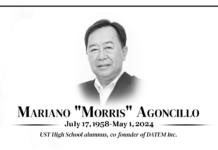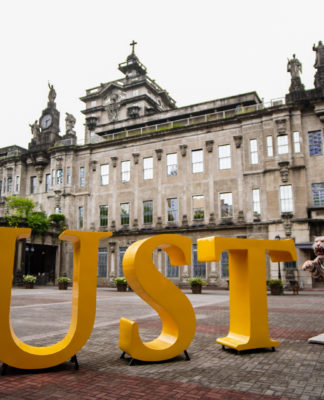THERE is great power bestowed on lawyers. Truth will prevail and justice will be served only if they do their job well and stay true to the oath they took. With the temptation posed by money and power on lawyers, rendering justice becomes a tougher job.
This is why the UST Faculty of Civil Law, in its more than two centuries of existence, remains committed to producing lawyers with Christian virtues and principles through sound Catholic legal education.
In its 269 years, the Faculty has produced four presidents, six chief justices, five associate justices, three Comelec chairmen, and several national heroes.
The Faculty was founded on September 2, 1734, making it the first lay school in the University and the first ever law school in the country. It was originally located in Intramuros. During the Japanese occupation from 1941 to 1945, the Faculty was closed.
The school reopened in 1945 at the Main Building of the University on España. Twenty years later, it transferred to the Commerce building until 1973, after which it relocated to the Medicine building.
Finally, in 1991, the Faculty of Civil Law returned to the Main Building. Renovations in its present location were made during the administrations of Rev. Fr. Rolando dela Rosa and Rev. Fr. Tamerlane Lana.
Facultad de Derecho Civil (1734-1898)
During the first years of the Faculty, its curriculum was identical with that of the leading universities in Europe. The course consisted of 12 semesters (six years) with a one-year preparatory course.
During these years, the great minds of the 1898 revolution were at one time students of the Faculty.
Apolinario Mabini, known more as the Great Paralytic, received his law degree from the University in 1894. Emilio Jacinto, the Katipunan brains, took up law in UST but had to stop in 1896 when he joined the revolution. Marcelo H. del Pilar, Felipe Agoncillo and Felipe Calderon were also students of the Faculty during the Spanish era.
Faculty of Civil Law (1898-1941)
During the American regime, the University was forced to change the curriculum of the Faculty of Civil Law to meet the standards of the changing times. However, the Faculty retained important subjects that were introduced during the Spanish era so as to fully accomplish its objective of developing men and women trained in the practice and principles of law and imbued with Christian virtues and principles. It was also in 1920, when the Faculty started accepting women as students.
During this period, the Faculty’s alumni became the leading lights of government. Manuel L. Quezon, a law student of the University until he stopped in 1899, was elected as the first president of the Philippine Commonwealth.
Under the Republic of the Philippines (1945- Present)
Although its curriculum has greatly evolved through the years, the Faculty’s academic discipline remains the same, defined by its old principles and objectives. It is now a four-year course which requires a bachelor’s degree in the arts or science.
After 269 years of existence, the Faculty of Civil Law has given the country four Philippine Presidents: Manuel L. Quezon (1935), Sergio Osmeña Sr. (1944-1946), Jose P. Laurel (1943), and Diosdado Macapagal (1961). It has also yielded six Chief Justices of the Supreme Court: Cayetano Arellano (1901-1920), Victorino M. Mapa (1920-1921), Manuel G. Araullo (1921-1924), Ramon Q. Avaceña (1925-1941), Roberto R. Concepcion (1966-1973), and Andres R. Narvasa (1992-1998).
The Faculty has also produced five Associate Justices of the Supreme Court (Claro M. Recto, Jose Y. Feria, Arturo B. Buena, Bernardo P. Pardo, and Angelina Gutierrez), 10 Associate Justcies of the Court of Appeals ( Isidor Borromeo, Arturo B. Buena, Jaime M. Lantin, Alfredo Banipayo, Serafin Guingona, Angelina Gutierrez, Bernardo Pardo, Oswaldo Agcaoili, Bernardo Abesamis, and Teodoro Regino), two Associate Justices of the Sandiganbayan (Harriet Demetriou and Diosdado M. Peralta.) and three Commission on Elections Chairmen (Harriet Demetriou, Bernardo Pardo and Alfredo Benipayo.)
Behind its continued are law deans who became instruments in the development of the Faculty since its foundation in September 1734. The eminent deans of the faculty are Ramon A. Salinas (1927-1928), Felicisimo R. Feria (1928-1941), Gabriela La O (1946-1949), Roberto R. Concepcion (1949-1952), Gregorio F. Hernandez (1952-1958), Ramon T. Oben (1958-1960), Antonio M. Molina (1960-1967), Andres R. Narvasa (1967-1973), Luis Y. Feria (1973-1976), Roberto R. Concepcion (1976-1979), Jose Y. Feria (1979-1985), Andres Narvasa (1985-1986), Eduardo P. Caguioa (1986-1989), Amado L. Dimayuga (1989-2001), and Jaime Lantin (2001- present).
From its first dean, Don Joaquin de Castañeda, to the present dean, Justice Jaime Lantin, the UST Faculty of Civil Law has and will continue to produce Thomasian lawyers who have, in one way or another, helped shape the destiny of our nation. Lutchie Anne C. Coral














